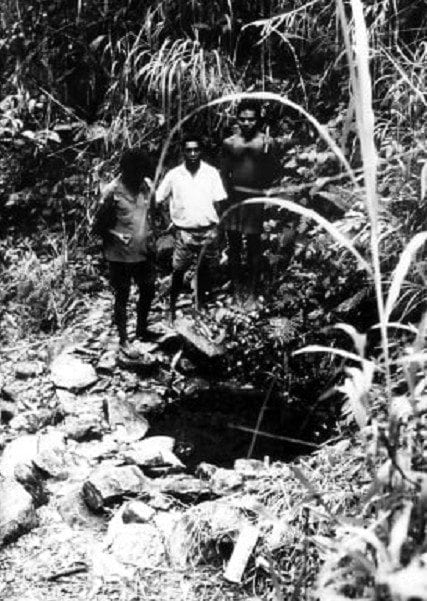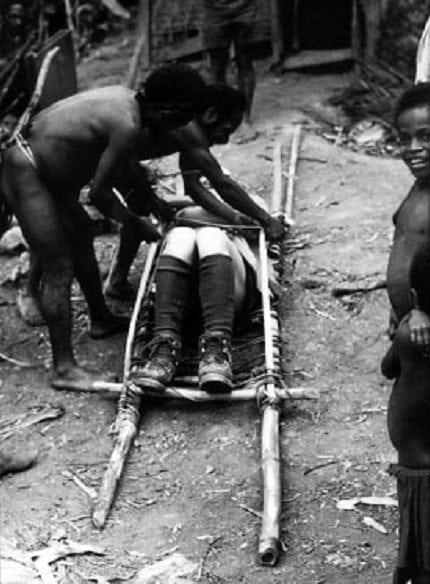The Cretin and the Pharoah
One of the true joys of being a student at the Liverpool School of Tropical Medicine was to be taught by Professor Peter Pharoah. Well, not so much to be taught by him, as to have him share intriguing insights and amazing adventures from his work in Papua New Guinea. Professor Pharoah’s mission, one that he enthusiastically embraced, was to confirm the cause of endemic cretinism:
Because endemic goitre is attributable to iodine deficiency and endemic cretinism is found only in areas where there is endemic goitre, it was hypothesised that endemic cretinism was also attributable to iodine deficiency. However, there was conflicting evidence concerning the hypothesis whether or not iodine deficiency was the cause of both endemic cretinism and endemic goitre.-
Pharoah POD. Dr Duncan’s legacy in a remote New Guinea valley. J Epidemiol Community Health 1999;53:794-800
What exactly is endemic cretinism? It is not to be confused with sporadic cretinism (clinical or congenital hypothyroidism), which is more widely described in textbooks:
The endemic variety of cretinism is a syndrome of neurological impairment comprising mental retardation, spastic diplegia/quadriplegia, deaf-mutism and occasionally, strabismus. In most countries where the disease is prevalent, clinical hypothyroidism is not a feature of the syndrome.
Pharoah POD. 1999
Pharoah and his colleagues decided to conduct a controlled trial [abstract] using intramuscular iodinated oil for the intervention group and physiological saline for the control group. The hypothesis being tested was that iodine replacement would prevent endemic cretinism. The trial started in 1996, with 8000 people recruited to each arm of the trial from the isolated Jimi Valley in the mountainous Western Highlands province of Papua New Guinea.
The idea for the trial was sparked by a serendipitous event:
The then Director of Public Health in Papua New Guinea, suffered from bronchiectasis and underwent radiographic bronchography with iodinated oil as the contrast medium. Several months later, a plain radiograph revealed droplets of the oil still present in the lungs. The director considered that, if the oil in his lungs was without untoward effect, it ought to be safe as a depot long term supply of iodine. Shortly afterwards he organised a trial of intramuscular iodinated oil for relieving and preventing endemic goitre that proved highly successful, many goitres vanished!
Pharoah POD. 1999
Professor Pharoah returned to the valley many times so that he could record all pregnancies, all births, and to examine all children born into the trial. I will never forget his film footage of the villages, with his vivid descriptions and nostalgic reliving of village life and his journeys in the Highlands, punctuated by exclamations such as, “Look! There’s a cretin!”, and “…wait, there’s another cretin!”. Interestingly, his data showed that there were very few adults with endemic cretinism.
At first he tried to explain this trend by assuming that “cretins” did not survive to adulthood. But this was not the case in other under-developed countries and:
Questioning the local populace always elicited the same answer, the disease came after the arrival of the white man! This fitted with the age specific pattern because the very first contact with the white man was in July 1953.
Was it that the “cretins” were deliberately killed soon after birth before they were exposed to missionary influences?
This also could not be the explanation because the mothers denied practising the infanticide of cretins although they were quite ready to admit that they practised infanticide for multiple births. Furthermore, the mothers lavish considerable care on the cretins, carrying them to and from the gardens in that difficult terrain.
Or did ritual cannibalism, including the consumption of thyroid glands, have a protective effect?
… the people in the valley strongly denied that they ever practised cannibalism…
After discussion with Richard Hornabrook, a pioneer in the study of Kuru, concerns were raised about the source of salt used by the Jimi valley people.
…before the white man came to the valley… [At the time of a] “salt treaty” the tribes from the Jimi valley would be allowed to travel unmolested through neighbouring territories to visit some salt pools… [which] entailed two days of strenuous walking.
The journey and the salt manufacture was a major communal event, the people would camp by the pools for one or two “moons” making sufficient salt, not only for their own use, but also for trading purposes.
Indeed, as Professor Pharoah reminded us, we should remember that origins of the English word “salary” come from salt, which was once used as currency by our own fore-fathers in the Western world. The first white men in the Jimi valley, knowing that salt was currency to the locals, brought in large quantities of the stuff. The white man’s salt was so easily available that the last tribal salt pool closed in 1958 – a year before the upsurge in endemic cretinism.
As a final piece of proof, Professor Pharoah collected and tested samples of water from the old pools from where the tribal salt was evaporated:
The salt has about twice the amount of iodine as the most heavily iodised salt produced commercially.
Thus was found the reason for an epidemic of endemic cretinism, which in 1965 affected 15% of the children of the Jimi Valley, but also the key to preventing the disease – iodine supplementation prior to conception. Ultimately, largely through the efforts of Australian Basil Hetzel, iodine supplementation programmes were established internationally.
Professor Pharoah returned to Papua New Guinea many times conducting further studies. Describing some of this work he gleefully pointed at the rugged terrain explaining, “See that hill there, that’s where my marriage nearly broke up… My wife refused to walk any further… so I left her behind.”. We students collectively chuckled to ourselves before realising that he wasn’t joking – he shook his head while muttering, “The next village was only a couple of hours away.”. Professor Pharaoh soon cheered himself by telling us about the torrid travails of his colleague Kevin Connolly, who somewhat surprisingly lives to this day:
The return journey to the mission station was proceeding uneventfully until Kevin stumbled and fell… He had sustained a Pott’s fracture.
To Kevin’s consternation insult was added to injury by his being strapped to the stretcher with vines having him in a fetal position rather like a trussed-up chicken! He had visions of being part of some cannibalistic ritual!…
At one point the path becomes very narrow as it traverses the face of a landslide… the stretcher tipped sideways and Kevin looked straight down the mountainside. His characteristic response was “Peter, I think I would rather get out and walk!
The injury itself, and his terrifying transportation, were only a small part of Kevin’s ordeal:
I explained all to Kevin seeking his opinion as to the desirability of the medicine man practicing his local therapeutic knowledge. Kevin’s response was to pass the decision back to me saying “You are my doctor, what do you think should be done”. In the interests of science I responded that I would dearly like to find out what the local treatment entailed!
He promptly disappeared into the bush and came back with some large leaves that he proceeded to stroke up and down the fractured ankle. The leaves turned out to be a variety of stinging nettle and its effect was evident by the urticaria that developed! The treatment was only an example of the counter irritation technique that was part of our therapeutic armentarium in years gone by. The theory behind it is that, if someone is in pain, apply another source of irritation and the original pain will be ameliorated.
And finally, to end on a serious but enlightening note, I give you Professor Pharoah’s succinct explanation of the hormonal and developmental basis for the difference between endemic cretinism and congenital hypothyroidism:
The normal cellular functioning of most organs is dependent on circulating T3. Brain cells differ in that they are dependent on circulating T4 and possess an intracellular deiodinating enzyme to convert T4 to T3. Thus T4 is crucial to normal cerebral function from conception to death. In early gestation, before the fetus can manufacture its own T4, it is dependent on the mother’s T4 and any deficiency at this stage of fetal neurological maturation leads to cerebral palsy, deaf-mutism and mental retardation. In late gestation and during infancy, the fetus/infant manufactures its own T4 and a failure of this mechanism leads to the clinical picture of congenital hypothyroidism.
Key reference: Pharoah, POD. Dr Duncan’s legacy in a remote New Guinea valley. J Epidemiol Community Health 1999;53:794-80
Chris is an Intensivist and ECMO specialist at The Alfred ICU, where he is Deputy Director (Education). He is a Clinical Adjunct Associate Professor at Monash University, the Lead for the Clinician Educator Incubator programme, and a CICM First Part Examiner.
He is an internationally recognised Clinician Educator with a passion for helping clinicians learn and for improving the clinical performance of individuals and collectives. He was one of the founders of the FOAM movement (Free Open-Access Medical education) has been recognised for his contributions to education with awards from ANZICS, ANZAHPE, and ACEM.
His one great achievement is being the father of three amazing children.
On Bluesky, he is @precordialthump.bsky.social and on the site that Elon has screwed up, he is @precordialthump.
| INTENSIVE | RAGE | Resuscitology | SMACC



